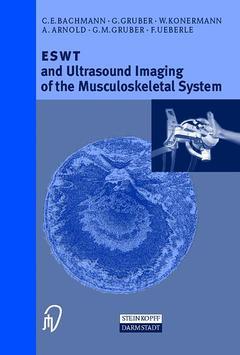Description
ESWT and Ultrasound Imaging of the Musculoskeletal System, Softcover reprint of the original 1st ed. 2001
Authors: Bachmann C.E., Gruber G., Konermann W., Arnold A., Gruber G.M., Ueberle F.
Language: English
Subject for ESWT and Ultrasound Imaging of the Musculoskeletal System:
49.99 €
Subject to availability at the publisher.
Add to cart
Publication date: 03-2001
135 p. · 15.5x23.5 cm · Paperback
135 p. · 15.5x23.5 cm · Paperback
Description
/li>Contents
/li>Comment
/li>
Extracorporeal Shock Wave Therapy (ESWT) is a new method for the treatment of numerous chronic disorders of the musculoskeletal system: Calcific tendinitis of the shoulder joint - Lateral epicondylitis - Medial epicondylitis - Plantar fasciitis - Pseudarthrosis.
Other indications are being investigated either in clinical studies or as empirical therapeutic possibilities of ESWT. This book gives a clear overview of the present status of ESWT and ultrasound imaging in the management of musculoskeletal disorders.
Other indications are being investigated either in clinical studies or as empirical therapeutic possibilities of ESWT. This book gives a clear overview of the present status of ESWT and ultrasound imaging in the management of musculoskeletal disorders.
1 Introduction.- 1.1 ESWT in Orthopedics.- 2 Introduction to Physical Principles of Shock Waves.- 2.1 Discovery of Shock Wave Applications in Medicine.- 2.2 Wave Patterns.- 2.3 Shock Wave Generation Systems.- 2.4 Technology of Shock Wave Generation.- 2.5 Dornier Electromagnetic Shock Wave Emitter (EMSE).- 2.6 Properties of Shock Waves.- 2.7 Shock Wave Focus.- 2.8 Pressure Field.- 2.9 Energy Flux Density and Effective Focal Energy.- 2.10 Aperture Angle.- 2.11 Cavitation.- 2.12 Measuring Methods.- 2.13 Biological Effects of ESWT.- 3 Extracorporeal Shock Wave Therapy Systems.- 3.1 Components of a Typical ESWT System.- 3.2 Targeting Aids for Localization using Patient Feedback.- 3.3 Localization Systems.- 4 Orthopedic Shock Wave Therapy.- 4.1 Energy Levels.- 4.2 Action Mechanism of Shock Wave Therapy.- 4.3 Orthopedic Indications for Shock Wave Therapy.- 4.4 Contraindications.- 4.5 Patient Information.- 5 Localization Techniques.- 5.1 Patient Feedback.- 5.2 Ultrasound.- 5.3 X-ray.- 5.4 Dual Imaging.- 5.5 Comparison of Imaging Procedures.- 6 Application Techniques.- 6.1 Tangential Coupling.- 6.2 Direct Coupling.- 7 Ultrasound Examination — Standard Ultrasound Cross Sectional Planes (DEGUM Recommendations).- 7.1 Introduction.- 7.2 Safety Aspects, Advantages and Disadvantages of Ultrasound Examinations.- 7.3 Technical and Physical Principles of Ultrasound Examinations.- 7.4 Configuration of Ultrasound Systems.- 7.5 Transducers, Imaging.- 7.6 Stand-offs.- 7.7 Artifacts and Phenomena.- 7.8 Important Basic Ultrasound Terms.- 7.9 Special System Adjustments and Problems of Ultrasound Examinations of the Musculoskeletal System.- 7.10 DEGUM Guidelines for Documentation and Evaluation.- 7.11 Typical Ultrasound Presentation of Selected Tissue Structures.- 8 Shoulder.- 8.1 Anatomy andPathology of the Periarticular Structures of the Shoulder.- 8.2 Standard Ultrasound Examination of the Shoulder.- 8.3 Calcific Tendinitis.- 8.4 Results.- 9 Elbow.- 9.1 Standard Ultrasound Examinations of the Elbow.- 9.2 Lateral Epicondylitis (Tennis elbow).- 9.3 Medial Epicondylitis (Golfer’s Elbow).- 9.4 Results.- 10 Foot and Ankle Joint.- 10.1 Standard Ultrasound Sectional Planes of the Ankle Joint and Foot.- 10.2 Plantar Fasciitis (Plantar Heel Spur).- 10.3 Results.- 11 Pseudarthrosis.- 11.1 Definition.- 11.2 Pathology.- 11.3 Clinical Diagnosis.- 11.4 Conservative and Surgical Therapy.- 11.5 ESWT.- 11.6 Results.- 12 Additional Literature on ESWT of the Musculoskeletal System.- 13 Additional Literature, Video Tapes and CD-ROMs on Ultrasound Examination of the Musculoskeletal System.
Description of defined indications for ESWT Application of the ESWT therapy head using ultrasound imaging for localization Presentation of standard sectional planes for ultrasound examination of joints Sonographic anatomy, application of ultrasound transducers and additional indications for ultrasound imaging
© 2024 LAVOISIER S.A.S.
These books may interest you

Tennis ElbowClinical Management 52.74 €



